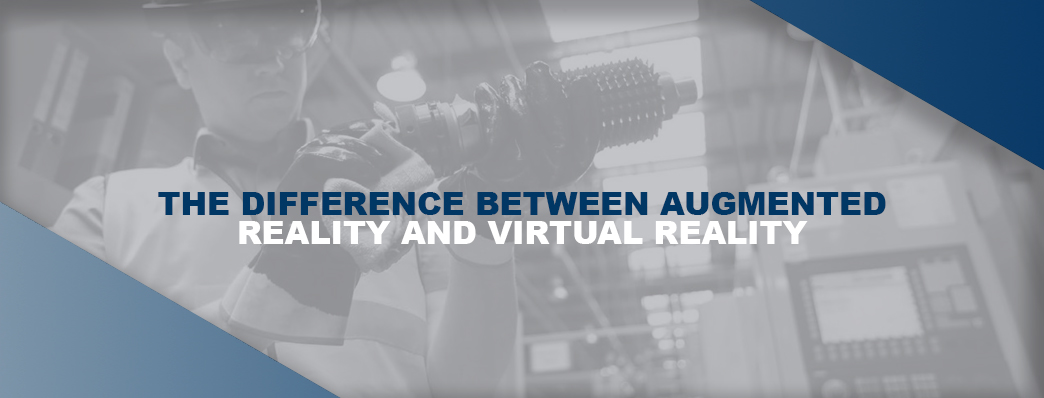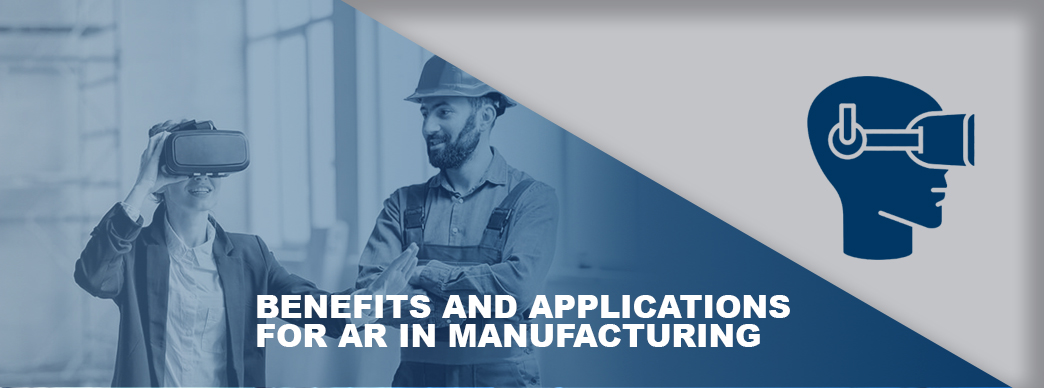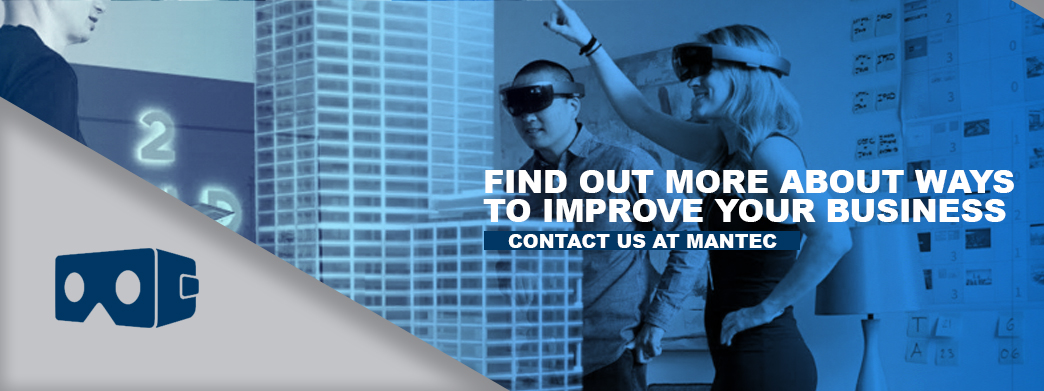In the complex and competitive world of manufacturing, where product quality and operational efficiencies are…
 Thanks to increasing innovations, manufacturing businesses can incorporate augmented reality and virtual reality into their operations. These forms of technology allow workers to accomplish tasks they would not be able to without these inventions. Are these systems right for your business? You won’t know until you’ve learned what makes this technology such an exciting addition to manufacturing.
Thanks to increasing innovations, manufacturing businesses can incorporate augmented reality and virtual reality into their operations. These forms of technology allow workers to accomplish tasks they would not be able to without these inventions. Are these systems right for your business? You won’t know until you’ve learned what makes this technology such an exciting addition to manufacturing.
Quick links
The Difference Between Augmented Reality and Virtual Reality | What Is Augmented Reality? | What Is Virtual Reality? | What Is Mixed Reality?
Benefits and Applications for AR in Manufacturing | Benefits of AR | Augmented Reality Applications
Training | Information Transfer | Schematics | Quality Assurance | Assembly
Closing Skills Gaps | Inventory Management | Benefits and Applications for VR in Manufacturing
Benefits of VR | Applications of VR | Design | Tool Inspection | Floor Planning
Future of AR and VR in the Manufacturing Industry | Find out More About Ways to Improve Your Business
The Difference Between Augmented Reality and Virtual Reality
 Both augmented and virtual reality have many similarities because both lie on the reality-virtuality continuum. This spectrum stretches out from the real world at one end to a completely virtual world at the other. Think about the differences between going outside and playing a video game. As you move from either extreme toward the center, you reach the realms of augmented and virtual reality, with mixed reality covering both.
Both augmented and virtual reality have many similarities because both lie on the reality-virtuality continuum. This spectrum stretches out from the real world at one end to a completely virtual world at the other. Think about the differences between going outside and playing a video game. As you move from either extreme toward the center, you reach the realms of augmented and virtual reality, with mixed reality covering both.
More Manufacturing Technology Resources
What Is Augmented Reality?
Augmented reality, or AR, allows a worker to see the real world as a background and elements to move virtually in the foreground. Often, AR technology uses a transparent screen or eyeglasses, onto which a headset projects virtual elements. This virtual overlay could include plans for a worker to follow, instructions or warning signs of dangerous conditions.
Augmented virtuality, or AV, is closely related to AR. The former technology uses real-world input devices to interact with a virtual world. Compared to AR, augmented virtuality relies more heavily on virtual images and less on real-world input, which places it closer to virtual reality on the reality-virtuality (RV) spectrum.
What Is Virtual Reality?
Virtual reality, or VR, creates a computer-generated space that resembles a real place. In manufacturing, factory planning or deciding to rearrange machines in the area can take place entirely in virtual reality before workers move machinery. Seeing how automation may help a factory’s productivity in a virtual environment is another way manufacturing can benefit from virtual reality.
What Is Mixed Reality?
Mixed reality incorporates elements of AR and VR. The part of the RV continuum that includes mixed reality is the stretch from AR to augmented virtuality. Anything that combines real-world elements with virtual images makes up mixed reality. How much of the real world the user sees will determine if the mixed-reality technology is closer to AR or AV. AR has more aspects of the real world in it, usually the background. AV uses small real-world elements in a virtual world. Both have their uses in manufacturing.
Benefits and Applications for AR in Manufacturing
 Augmented reality already shows promise for a variety of sectors of the manufacturing industry. With multiple applications, facilities that choose to incorporate AR and AV will find no end to the uses they get from this technology.
Augmented reality already shows promise for a variety of sectors of the manufacturing industry. With multiple applications, facilities that choose to incorporate AR and AV will find no end to the uses they get from this technology.
Benefits of AR for Manufacturers
Bringing digital views to the real world enhances operations by making workers’ jobs safer, more efficient and less costly. While your workers could access the AR technology on a smartphone, tablet or goggles, using goggles may be a better choice for certain tasks. Eyewear frees the worker’s hands for the task they need to accomplish. However, tablets and smartphones are more readily available options that cost less. The number of equipment choices for AR gives this technology an advantage over VR, but whether you choose AR or VR will depend on the uses you need the technology for.
Augmented Reality Applications
Training is one of the best ways to incorporate AR and AV into manufacturing. Using computer-generated situations, trainees get a broader range of experiences than with traditional training, without putting themselves or others at risk. Information transfer and inventory management are two more of the many ways you can use AR in your facility. Learn about these and other applications of AR.
Train Manufacturing Employees Using VR
One study examined how training workers with a variety of stress situations would benefit from AV. The study recreated a physical training model of the equipment in virtual reality. The worker saw this model in a VR headset, but he physically moved parts of the real model, creating augmented virtuality. Using a computer to change various conditions, the researchers challenged the worker to several situations — working in a dark room with a flashlight, responding to escaping steam from one valve and reacting to slowly leaking steam and water from multiple sources.
Information Transfer
With more manufacturing workers retiring and fewer taking their place, a skills gap has opened across multiple industrial sectors. Between 2018 and 2028, the number of unfilled, skilled positions could reach 2.4 million. Within the next three years, skilled production workers will be among job openings that are three times harder to fill. To solve the problem of this skills gap, older workers will need to help more new employees by transferring their wealth of knowledge through AR.
In one instance of using AR for this type of information transfer, a company puts headsets on longtime maintenance workers as they make repairs around the facility. The camera on the headset records everything workers do while they narrate the process, creating a how-to video. Future workers will have access to these videos from their headsets so they can see how to repair equipment while looking at the part that needs fixing. Creating these types of procedural instructions workers can access with AR cuts training time by 37 percent and the time to document directions by 75 percent.
Schematics
With maintenance tasks, occasionally workers would need to refer to paper schematics before making repairs or part replacements. With AR, however, the schematics will appear virtually before a worker’s eyes. They won’t need to waste time finding the layout of the machinery they’re fixing. By incorporating AR to provide the plans, maintenance times could decrease by half.
Quality Assurance
Ensuring quality through human visual checks can result in mistakes, but holding up an AR screen over an object makes it easier for a human reviewer to spot problems with the product. This way, errors happen less frequently, resulting in better production and product quality.
Assembly
Even long-time workers may need some help with new assembly techniques. Using AR goggles or a tablet overlays the instructions for piecing together parts. This overlay function ensures the worker properly aligns pieces to their required positions and correctly installs them. With a little help during the assembly process, you can reduce worker errors and improve your facility’s productivity.
Closing Skills Gaps
Experienced workers in manufacturing are hard to find, but they can easily pass knowledge on to new workers through AR. The new workers can wear a camera-equipped headset that captures what they see. If a problem arises, the worker can contact an off-site expert to consult with for information on solving it. Experts no longer have to travel to multiple facilities to see the problem in real time. With AR, their skills get spread to numerous factories, saving them time and allowing your workers to get more timely answers to their questions.
Inventory Management
Finding goods in storage once required workers opening boxes to examine their contents or wander around a facility to locate the right box. With AR, the process of managing inventory is easier. In the Netherlands, DHL used AR to help its workers pick stock faster from a warehouse. Wearing hands-free glasses with AR-embedded technology, 10 workers picked 20,000 items in only three weeks, fulfilling 9,000 orders. Because they did not need paper picking slips or handheld scanners, the workers could focus on more quickly retrieving goods. Their efficiency increased by 25 percent, while the number of errors dropped to zero.
Benefits and Applications for VR in Manufacturing
Virtual reality is just as helpful for improving your business as AR. Unlike augmented reality, which allows a view of the real world, VR is an entirely computer-created environment. By having everything from the background to the things the worker interacts with in the computer, changing them become much easier. VR offers greater versatility, especially for planning and training situations.
Benefits of VR
Though you will require a monetary investment in the technology, you could see a return on your investment from the money you save and the increase in productivity you receive. Like AR, the multi-faceted uses of this technology make it a smart investment for many manufacturing facilities.
Applications of VR
VR’s ability to adapt to a variety of changes beyond what exists in the environment gives this type of technology an edge in some training situations. Planning and inspecting extra-large pieces you otherwise could not see without visiting the creator’s facility are other applications that add to the benefits of using VR. With this technology, you can interact with items without needing to physically be in the same room with them.
How you use VR in your facility is up to you, but there are numerous applications from which to choose. You may want to see how automation will affect your facility and where you can best implement it. VR could help you to plan your factory around the automation upgrades. Planning is only one way you can integrate VR into your manufacturing facility’s operations.
Design
Designing and building new creations was once only possible by using paper or in a 3D computer program, but VR allows a more in-depth look inside, above, below and around the design. Ford sees the advantages of using VR for designing so clearly the company requires VR design as part of its new vehicle creation.
Tool Inspection
Not every tool and piece of equipment designers create can travel to conventions or find space in the company’s showroom. To solve the problems, some companies turn to VR headsets that allow users to get a close-up look at their offerings without needing to see the machinery in person. With a VR environment, you can see a virtual recreation of the machinery from all angles and witness it in action. When investing in new machinery for your facility, you want to make the most informed decision possible, and VR gives you a better look at the product than a catalog will.
Floor Planning Using VR
Once you’ve purchased new machinery, you need to determine where to place it. Factory planning in VR gives you the chance to quickly move equipment around to maximize productivity. You also can rearrange your shelving, machinery and storage if you want to switch to automation. One company that uses VR for planning uses the original CAD files of the equipment in the factory. By doing this, the VR system replicates the facility as closely as possible.
Training
If you don’t need the workers to physically interact with a mock interface by turning dials and moving switches, VR training may be an option. The downside to VR training is the inability of a worker to feel the dials beneath their hands, but you have greater versatility in the machinery you can train a worker on by using VR.
VR allows workers the chance to practice what they would do in emergencies without needing to conduct drills for everyone at once. Using VR, a worker can experience what would happen if an emergency required evacuation from their workstation in the building or how to respond to an accident on the factory floor. Adding virtual workers to the simulation makes the training more challenging by teaching the worker what to do when there are several people around.
Future of AR and VR in the Manufacturing Industry
 AR and VR are just starting to take off in manufacturing. The future of the industry will likely see increased use of both technologies for a variety of applications, from assembly to factory planning. In 2018, VR and AR had respective markets of $7.9 billion and $11.14 billion. By 2023, experts anticipate these numbers to rise to $34.08 billion for VR and $60.55 billion for AR. With such sharp increases in the market values for AR and VR, you will fall behind in the manufacturing world if you don’t embrace this technology.
AR and VR are just starting to take off in manufacturing. The future of the industry will likely see increased use of both technologies for a variety of applications, from assembly to factory planning. In 2018, VR and AR had respective markets of $7.9 billion and $11.14 billion. By 2023, experts anticipate these numbers to rise to $34.08 billion for VR and $60.55 billion for AR. With such sharp increases in the market values for AR and VR, you will fall behind in the manufacturing world if you don’t embrace this technology.
In 2015, only 35.5 percent of manufacturing facility operators reported no plans to adopt VR or AR within the next three years and did not currently use it. The same survey showed only 27.5 percent of responders thought VR would not be significant in enhancing competitiveness for manufacturers within the next three years. The remainder of those taking the survey ranked VR as anywhere from moderately important to extremely important in creating a more competitive business.
Clearly, those in the manufacturing sector see how important VR and mixed-reality technologies are to their businesses. Is incorporating VR, AR or AV a wise choice for your company? Making this decision and others about your business may require some additional help from MANTEC.
Find out More About Ways to Improve Your Business
 Are AR and VR right for your manufacturing processes? At MANTEC, we help companies become better. When you reach out to us, you take the first step toward growing your business. Surveys of other manufacturers we’ve worked with have shown our track record of getting a return on our clients’ investments. We’ll help you make decisions about AR and VR use in your facility, as well as other ways you can make your manufacturing business more profitable and useful. Contact us at MANTEC to see how we can improve your business through AR technology or other improvements.
Are AR and VR right for your manufacturing processes? At MANTEC, we help companies become better. When you reach out to us, you take the first step toward growing your business. Surveys of other manufacturers we’ve worked with have shown our track record of getting a return on our clients’ investments. We’ll help you make decisions about AR and VR use in your facility, as well as other ways you can make your manufacturing business more profitable and useful. Contact us at MANTEC to see how we can improve your business through AR technology or other improvements.


